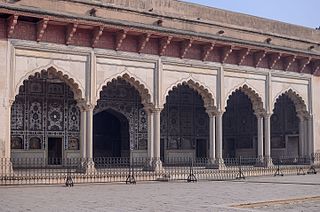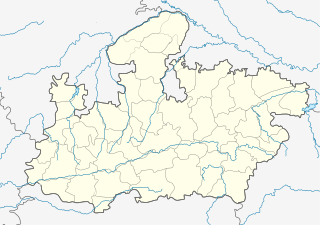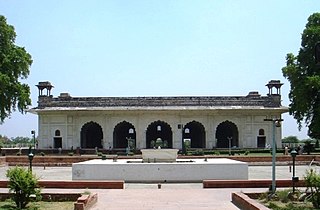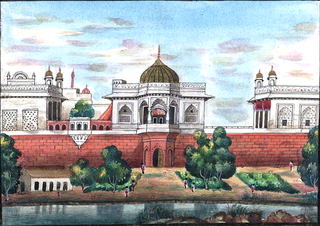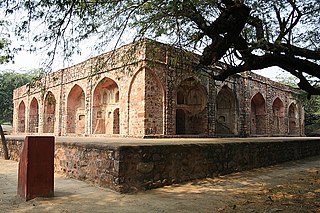Coordinates: 28°39′16″N77°14′36″E / 28.654494°N 77.243445°E

A geographic coordinate system is a coordinate system that enables every location on Earth to be specified by a set of numbers, letters or symbols. The coordinates are often chosen such that one of the numbers represents a vertical position and two or three of the numbers represent a horizontal position; alternatively, a geographic position may be expressed in a combined three-dimensional Cartesian vector. A common choice of coordinates is latitude, longitude and elevation. To specify a location on a plane requires a map projection.

The Mumtaz Mahal (Hindustani: ممتاز محل, मुमताज़ महल, literally Jewel Palace) is located in the Red Fort, Delhi.
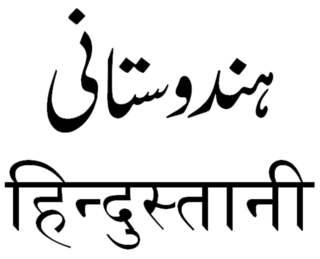
Hindustani, also known as Hindi-Urdu and historically also known as Hindavi, Dehlavi and Rekhta, is the lingua franca of Northern India and Pakistan. It is an Indo-Aryan language, deriving its base primarily from the Khariboli dialect of Delhi. The language incorporates a large amount of vocabulary from Prakrit, Sanskrit, as well as Persian and Arabic. It is a pluricentric language, with two official forms, Modern Standard Hindi and Modern Standard Urdu, which are its standardised registers. According to Ethnologue's 2019 estimates, if Hindi and Urdu are taken together as Hindustani, the language would be the 3rd most spoken language in the world, with approximately 409.8 million native speakers and 785.6 million total speakers.
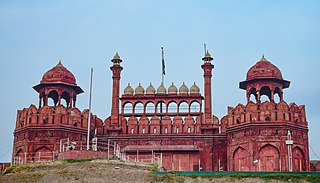
The Red Fort is a historic fort in the city of Delhi in India. It was the main residence of the emperors of the Mughal dynasty for nearly 200 years, until 1856. It is located in the centre of Delhi and houses a number of museums. In addition to accommodating the emperors and their households, it was the ceremonial and political center of the Mughal state and the setting for events critically impacting the region.

Delhi, officially the National Capital Territory of Delhi (NCT), is a city and a union territory of India containing New Delhi, the capital of India. It is bordered by Haryana on three sides and by Uttar Pradesh to the east. The NCT covers an area of 1,484 square kilometres (573 sq mi). According to the 2011 census, Delhi's city proper population was over 11 million, the second-highest in India after Mumbai, while the whole NCT's population was about 16.8 million. Delhi's urban area is now considered to extend beyond the NCT boundaries and include the neighboring satellite cities of Faridabad, Gurgaon, Sonipat, Ghaziabad and Noida in an area now called Central National Capital Region (CNCR) and had an estimated 2016 population of over 26 million people, making it the world's second-largest urban area according to United Nations. As of 2016, recent estimates of the metro economy of its urban area have ranked Delhi either the most or second-most productive metro area of India. Delhi is the second-wealthiest city in India after Mumbai, with a nominal economy of $110 billion for the entire Union Territory, and is home to 18 billionaires and 23,000 millionaires.
The Mumtaz Mahal is one of the six main palaces that were situated facing the Yamuna River. All six palaces were connected by the Stream of Paradise (Nahr-i-Bishisht), a waterway which ran through them. At one time the Chhoti Baithak, which no longer exists, was located just to the north of the Mumtaz Mahal. [1]
The building was constructed with white marble in the lower half of its walls and pillars. It consists of six apartments divided by arched piers and was originally painted with floral decorations on the interior. The Mumtaz Mahal was part of the Zenana. [1] After the British occupied the fort, it was used as a prison camp. [2]

Marble is a metamorphic rock composed of recrystallized carbonate minerals, most commonly calcite or dolomite. Marble is typically not foliated, although there are exceptions. In geology, the term "marble" refers to metamorphosed limestone, but its use in stonemasonry more broadly encompasses unmetamorphosed limestone. Marble is commonly used for sculpture and as a building material.
The building currently houses an exhibition of the Red Fort Archaeological Museum, consisting largely of exhibits of the Mughal period. [1]

The Red Fort Archaeological Museum is currently located in the Mumtaz Mahal of the Red Fort in Delhi, northern India. The museum contains paintings, artifacts, calligraphy, fabrics and other objects dating from the Mughal era.



